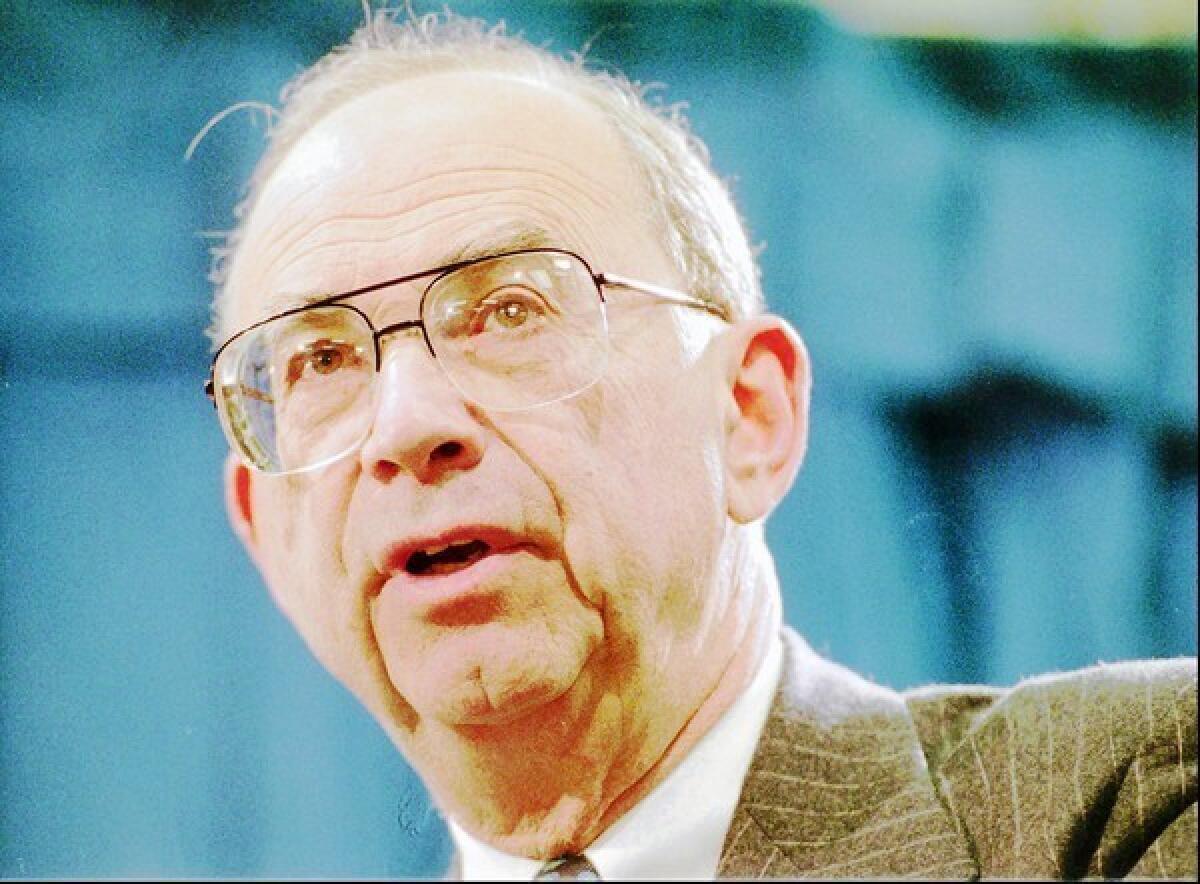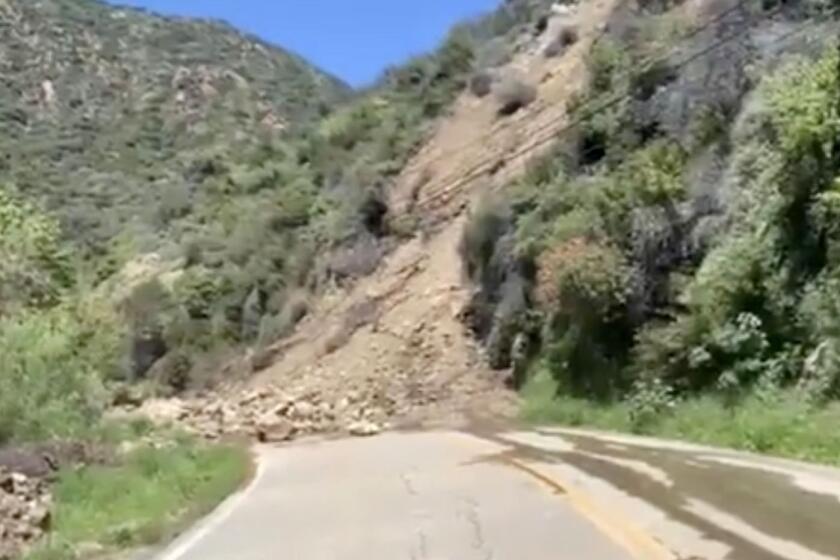High-speed rail’s strongest backers now express reservations

The California bullet-train project has collided with farmers, political conservatives and wealthy suburbanites who would like to see the $68-billion system killed. Now it is facing tough criticism from an unlikely quarter: within the ranks of high-speed rail’s true believers.
Some longtime backers of the project are objecting to political compromises that they say undermine legal safeguards for the massive investment, notably a design that would move passengers between urban destinations faster than air travel, as well as requirements intended to prevent a half-built system.
Among those raising objections is a Bay Area high-speed rail trailblazer who for decades played a pivotal role in building public and political support for the system. Quentin Kopp chaired the state Senate transportation committee for years and co-wrote legislation that launched the bullet-train project. He later served as board chairman of the state agency overseeing construction of the system.
But in a recent legal declaration, filed in a civil suit seeking to halt the project, Kopp, a retired judge, said the project as now planned violates the law underpinning $9.95 billion in state financing approved by voters in 2008. The declaration puts Kopp in the improbable position of supporting a suit by key rail antagonists: officials in Kings County and two farmers supported by powerful agriculture interests.
“They have just mangled this project,” Kopp said. “They distorted it. We don’t get a high-speed rail system. It is the great train robbery.”
Lynn Schenk, a former congresswoman from San Diego and current board member of the state rail authority, is another leading high-speed rail advocate. She stunned a room full of bullet-train supporters this month when she opposed a critical deal with a Northern California transit agency. Without the agreement, the political coalition supporting the project could unravel.
Dan Richard, chairman of the California High Speed Rail Authority, said that the new criticism and the lawsuit are wrong factually and legally. Deals to share sections of urban track with slower commuter rail systems, and to send massive investments to Southern California and Bay Area transit agencies, were critical to securing broad statewide political support for the project, he said.
“It is one thing to sit back and criticize, and it is another thing to build something,” Richard said. “We have made tremendous progress.”
Critics such as former World Bank executive William Grindley, however, say Richard is steamrolling those who are raising legitimate issues. They argue that the bullet train’s operational efficiency risks being so compromised that the system will fail to attract ridership needed to avoid public subsidies.
In his declaration, Kopp says that the bullet train business plan approved last year by the authority violates several voter-imposed requirements, and the project “is no longer a genuine high speed rail system.”
Among the taxpayer safeguards are requirements that construction of the system occur in “usable segments” and that the state have funding in hand to complete each segment before the start of construction. Kopp said he helped craft the provision when he headed the rail authority.
He says the current plan to build 130 miles of rail in the Central Valley for $6 billion, starting this summer, will not produce a usable segment. The first truly feasible segment of passenger service in the state’s plan would connect Merced to the San Fernando Valley at an estimated cost of $31 billion, Kopp said. And the state does not have that kind of money in sight. The initial section of track is a “subset of a usable segment” and violates a fundamental mandate intended to protect the state from starting a project it can’t complete, Kopp’s declaration asserts.
Kopp also says current plans for a so-called blended system, in which bullet trains would share tracks with local commuter trains from Gilroy to San Francisco, is at odds with voter approvals. The plan was meant to quell opposition to bullet trains running through the wealthy communities of Silicon Valley. But Kopp maintains that it could slow bullet trains too much, violating a legal requirement that at least some trips between Los Angeles and San Francisco not exceed two hours and 40 minutes. And agreements to upgrade local rail systems also violate the law by diverting bullet-train bond money for other work not agreed to by voters, Kopp contends.
The controversy over speed refuses to die. The rail authority recently released a memo stating that its trains will beat the two-hour, 40-minute mandate, but critics said it was based on unrealistic assumptions and actually supported claims that the system would not comply with the law.
It was concern about the blended system that prompted Schenk this month to oppose an agreement with Bay Area transportation agencies. At a board meeting meant to celebrate approval of the deal, Schenk recounted her long support of the bullet-train concept and then stunned project backers by announcing that she could not vote for the agreement “at the expense of the ultimate goal of high-speed rail.”
Richard pleaded with her to reconsider and cast a “courtesy” vote to allow the deal to proceed, but Schenk declined. The approval was postponed two weeks, until another board member was available.
Richard said bullet trains around the world use blended systems and typically run at slower speeds in urban areas. And he noted that opinions by the attorney general and the state legislative counsel support the legality of the current plan.
On the question of whether the first portion of construction complies with the law, E. Erik Lange, a legislative counsel deputy, opined last June, “We do not think ‘usable’ in the context of ‘usable segment’ necessarily means ‘usable by high speed trains.’ ” Some transportation experts who helped craft the language of the 2008 bullet-train ballot measure disagreed. But the opinion has bolstered the rail authority’s confidence that it can defend the design compromises it has approved.
“It is going to get built, but it is going to get built ugly,” said one bullet-train advocate close to the state rail authority.
Kopp and Schenk are not the only prominent, longtime rail backers raising new concerns.
Jim Mills, an early bullet-train booster as a former president pro tem of the state Senate and a former rail agency chief, said he also is increasingly convinced that the current project plan violates the 2008 ballot measure approved by voters. Like Kopp, he expressed those concerns in a declaration filed in the Kings County lawsuit, which is scheduled for trial in late May.
Still, a powerful array of Democrats, including Gov. Jerry Brown, Rep. Nancy Pelosi of San Francisco, U.S. Sen. Dianne Feinstein of California and President Obama, are backing the current plan. And some legal observers doubt a trial judge would block a voter-approved project supported by the political establishment.
But critics note that polls show voter support has eroded since 2008. A recent statewide survey found 54% of likely voters now oppose the project.
More to Read
Start your day right
Sign up for Essential California for news, features and recommendations from the L.A. Times and beyond in your inbox six days a week.
You may occasionally receive promotional content from the Los Angeles Times.






